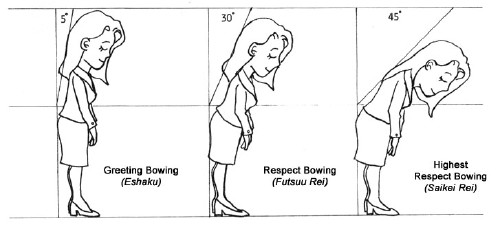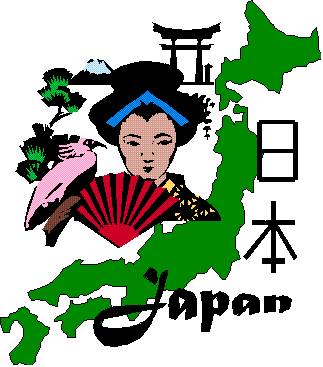As I have been saying in my previous post, non-verbal communication is very important. However, how many of us thought would our gestures, posture and way of greeting be perceived in a different way as we travel around the world? Unfortunately, many of us tend to ignore this kind of details when planning overseas trips, consequently we often come across as impolite and rude people. Knowing customs of other countries may help to make our overseas experience more exciting and help us to make new friends in different parts of the world. Lets have a look at some peculiarities of cultural values in Japan.
o GREETING GESTURES
§ The graceful act of bowing is the traditional greeting.
§ However, they have also adopted the western custom of shaking hands, albeit with a light grip and perhaps with eyes averted. Meanwhile, to show respect for their customs, it would flatter them to offer a slight bow when being introduced.
§ Avoid hugging and kissing when greeting.
§ It is considered rude to stare. Prolonged direct eye contact is considered impolite or even intimidating.
§ It is considered rude to stand with your hand or hands in your pockets, especially when greeting someone or when addressing a group of people.
§ The seemingly simple act of exchanging business cards is more complex in Japan
o TOUCHING GESTURES
§ The Japanese are not a touch-oriented society, so avoid open displays of affection, touching or any prolonged form of body contact.
§ Queues are generally respected; it is only in crowded train and subway stations where the huge volume of people causes touching and pushing.
o BECKONING GESTURES
§ It is considered insulting to point to someone fingers extended and the thing folded into the palm.
§ To beckon someone, the palm faces downward and the fingers are moved in a scratching motion.
o OTHER NONVERBAL GESTURES
§ Because of the high regard for graciousness and restraint, one should not shout, raise the voice in anger, or exhibit any excessively demonstrative behavior.
§ Among the Japanese, smiling often can cover a gamut of emotions: happiness, anger, confusion, apologies, or sadness.
§ Displaying an open mouth (such as yawning or a wide-open laugh) is considered rude in Japan
§ Silence (listening) is a sign of politeness and of contemplation. During conversations, be especially careful about interrupting.
§ One way to show concentration and attentiveness is to close the eyes in contemplation and nod the head slight, up and down.
o OTHER NONVERBAL GESTURES
§ The "O.K." gesture in Japan
§ Blowing your nose in public is considered rude.
§ When entering a private home or traditional restaurants with tatami (bamboo mats) floors, it is usually customary to remove your shoes and place them with the toes pointing toward the outdoors.
o BOWING
§ Many westerners view the bow as an act of subservience, but in Japan Asia .
 § Although it is not necessary, but a slight bow demonstrates that you respect their customs. Moreover, in
§ Although it is not necessary, but a slight bow demonstrates that you respect their customs. Moreover, in Retrieved from: http://www.csupomona.edu/~tassi/gestures.htm#asian

No comments:
Post a Comment